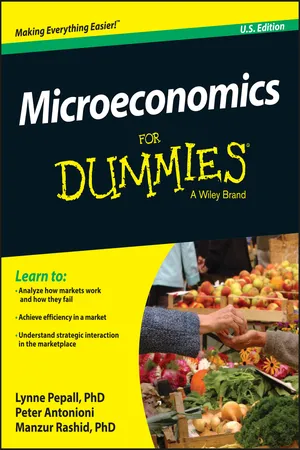
- English
- ePUB (mobile friendly)
- Available on iOS & Android
Microeconomics For Dummies
About this book
The study of microeconomics isn't for the faint of heart. Fortunately, Microeconomics For Dummies is here to help make this tough topic accessible to the masses. If you're a business or finance major looking to supplement your college-level microeconomics coursework—or a professional who wants to expand your general economics knowledge into the microeconomics area—this friendly and authoritative guide will take your comprehension of the subject from micro to macro in no time! Cutting through confusing jargon and complemented with tons of step-by-step instructions and explanations, it helps you discover how real individuals and businesses use microeconomics to analyze trends from the bottom up in order to make smart decisions.
Snagging a job as an economist is fiercely competitive—and highly lucrative. Having microeconomics under your belt as you work toward completing your degree will put you head and shoulders above the competition and set you on the course for career advancement once you land a job. So what are you waiting for?
- Analyze small-scale market mechanisms
- Determine the elasticity of products within the market systems
- Decide upon an efficient way to allocate goods and services
- Score higher in your microeconomics class
Everything you need to make microeconomics your minion is a page away!
Frequently asked questions
- Essential is ideal for learners and professionals who enjoy exploring a wide range of subjects. Access the Essential Library with 800,000+ trusted titles and best-sellers across business, personal growth, and the humanities. Includes unlimited reading time and Standard Read Aloud voice.
- Complete: Perfect for advanced learners and researchers needing full, unrestricted access. Unlock 1.4M+ books across hundreds of subjects, including academic and specialized titles. The Complete Plan also includes advanced features like Premium Read Aloud and Research Assistant.
Please note we cannot support devices running on iOS 13 and Android 7 or earlier. Learn more about using the app.
Information
Getting Started with Microeconomics





Discovering Why Microeconomics Is a Big Deal



Peering into the Economics of Smaller Units
Making Decisions, Decisions, and More Decisions!
- Optimal: Getting the best of what you want, given what’s available.

- Sub-optimal: Getting less than the best.
- Consumers base their decisions on the value they get from choosing one option as opposed to another.
- Companies base their decisions on a measure of monetary benefit — revenue against costs.
Addressing how individuals and companies make decisions
Table of contents
- Cover
- Title Page
- Table of Contents
- Introduction
- Part I: Getting Started with Microeconomics
- Part II: Doing the Best You Can: Consumer Theory
- Part III: Uncovering the Alchemy of Firms’ Inputs and Outputs
- Part IV: Delving into Markets, Market Failure, and Welfare Economics
- Part V: Thinking Strategically: Life Is Just a Game!
- Part VI: The Part of Tens
- Glossary
- About the Author
- Cheat Sheet
- Advertisement Page
- Connect with Dummies
- End User License Agreement


